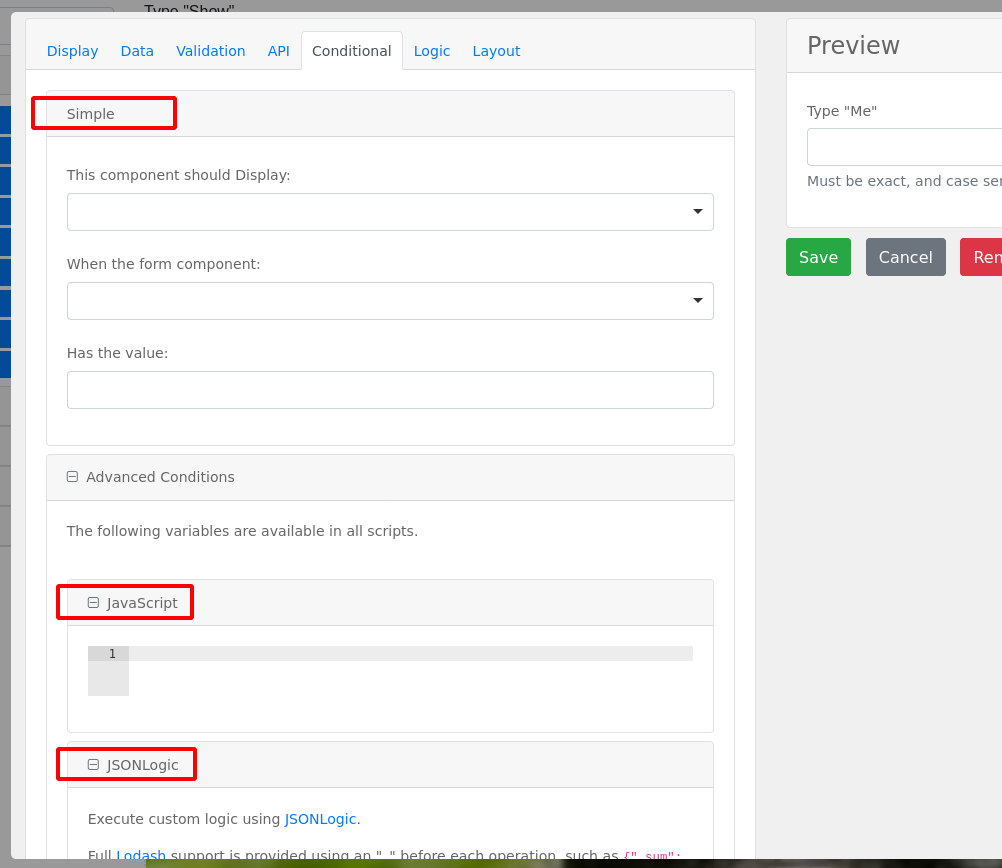formio.js (JSON Form Builder) data API for Python.
For information about the formio.js project, see https://github.com/formio/formio.js
python-formio-data is a Python package, which loads and transforms
formio.js Builder JSON and Form JSON into usable Python objects.
It's main aim is to provide easy access to a Form its components/fields, also
captured as Python objects, which makes this API very versatile and usable.
Notes about terms:
- Builder: The Form Builder which is the design/blueprint of a Form.
- Form: A filled-in Form, aka Form submission.
- Component: Input (field) or layout component in the Form Builder and Form.
- Compatible with Python 3.6 and later
- Constructor of the Builder and Form class, only requires the JSON and an optional language code for translations.
- Get a Form object its Components as a usable object e.g. datetime, boolean, dict (for select component) etc.
- Open source (MIT License)
The source code is currently hosted on GitHub at: https://github.com/novacode-nl/python-formio-data
Binary installers for the latest released version are available at the Python Package Index
pip(3) install formio-dataTo support conditional visibility using JSON logic, you can install
the json-logic-qubit package (the json-logic package it is forked
off of is currently unmaintained). It's also possible to install it
via the pip feature json_logic like so:
pip(3) install -U formio-data[json_logic]Convenient for developers. Also useful for running the (unit)tests.
git clone [email protected]:novacode-nl/python-formio-data.git
poetry installWhen working in the project itself, use
poetry install -E json_logicOptional dependencies need to be installed separately.
pip(3) install -U -e python-formio-dataYou can use nixpkgs to run a self-contained Python environment without any additional setup. Once you've installed nixpkgs, switch into the directory and type "nix-shell" to get a shell from which the correct Python with packages is available.
If you're using direnv, use direnv allow
after changing into the project directory and you're good to go. Also
consider nix-direnv to
speed up the experience (it can re-use a cached local installation).
All contributions, bug reports, bug fixes, documentation improvements, enhancements and ideas are welcome.
For more examples of usage, see the unit-tests.
>> from formiodata import Builder, Form
>>
# builder_json is a formio.js Builder JSON document (text/string)
# form_json is a formio.js Form JSON document (text/string)
>>
>> builder = Builder(builder_json)
>> form = Form(builder, form_json)
##################
# input components
##################
# textfield label
>> print(form.input_components['firstname'].label)
'First Name'
# textfield value
>> print(form.input_components['firstname'].value)
'Bob'
# datetime label
>> print(form.input_components['birthday'].label)
'Birthday'
# datetime value
>> print(form.input_components['birthday'].value)
'2009-10-16'
>> print(form.input_components['birthday'].to_date())
datetime.date(2009 10 16)
# datagrid (rows property)
>> print(form.input_components['datagridMeasurements'].rows)
[
{'measurementDatetime': <datetimeComponent>, 'measurementFahrenheit': <numberComponent>},
{'measurementDatetime': <datetimeComponent>, 'measurementFahrenheit': <numberComponent>}
]
>> for row in form.input_components['datagridMeasurements'].rows:
>> dtime = row['measurementDatetime']
>> fahrenheit = row['measurementFahrenheit']
>> print(%s: %s, %s: %s' % (dt.label, dt.to_datetime(), fahrenheit.label, fahrenheit.value))
Datetime: datetime.datetime(2021, 5, 8, 11, 39, 0, 296487), Fahrenheit: 122
Datetime: datetime.datetime(2021, 5, 8, 11, 41, 5, 919943), Fahrenheit: 131
# alternative example, by getattr
>> print(form.data.firstname.label)
'First Name'
>> print(form.data.firstname.value)
'Bob'
###################
# validation errors
###################
>> print(form.validation_errors())
{
'companyName': 'Company Name is required',
'editgridActivities': [
{'description': 'Description is required'},
{}, # no validation error (row 2)
{}, # no validation error (row 3)
{'description': 'Description is required', 'startDate': 'Start Date is required'}
]
}
#############################
# component path (properties)
#############################
# datagrid input
>> datagridMeasurements = builder.components['datagridMeasurements']
# builder_path
>> [
>> print(row.input_components['measurementDatetime'].builder_path)
>> for row in datagridMeasurements.rows
>> ]
[<panelComponent>, <columnsComponent>, <datagridComponent>, <datetimeComponent>]
# builder_path_key
>> [
>> print(row.input_components['measurementDatetime'].builder_path_key)
>> for row in datagridMeasurements.rows
>> ]
['pageMeasurements', 'columnsExternal', 'datagridMeasurements', 'measurementDatetime']
# builder_path_labels
>> [
>> print(row.input_components['measurementDatetime'].builder_path_labels)
>> for row in datagridMeasurements.rows
>> ]
['Page Measurements', 'Columns External', 'Data Grid Measurements', 'Measurement Datetime']
# builder_input_path
>> [
>> print(row.input_components['measurementDatetime'].builder_input_path)
>> for row in datagridMeasurements.rows
>> ]
[<datagridComponent>, <datetimeComponent>]
# builder_input_path_key
>> [
>> print(row.input_components['measurementDatetime'].builder_input_path_key)
>> for row in datagridMeasurements.rows
>> ]
['datagridMeasurements', 'measurementDatetime']
# builder_input_path_labels
>> [
>> print(row.input_components['measurementDatetime'].builder_input_path_labels)
>> for row in datagridMeasurements.rows
>> ]
['Data Grid Measurements', 'Measurement Datetime']
#################################
# components (layout, input etc.)
#################################
# columns
>> print(form.components['addressColumns'])
<columnsComponent>
>> print(form.components['addressColumns'].rows)
[
{'firstName': <textfieldComponent>, 'lastName: <textfieldComponent>},
{'email': <emailComponent>, 'companyName: <textfieldComponent>}
]
##########################
# components class mapping
##########################
# Below an example which verbosely shows the feature:
# - First set a custom component type 'custom_editgrid' in the Builder JSON schema.
# - Check (assert) whether the component object is an instance of the mapped editgridComponent.
# This code is also present in the unittest (file): tests/test_component_class_mapping.py
schema_dict = json.loads(self.builder_json)
# change 'editgrid' type to 'custom_editgrid'
for comp in schema_dict['components']:
if comp['key'] == 'editGrid':
comp['type'] = 'custom_editgrid'
component_class_mapping = {'custom_editgrid': editgridComponent}
builder = Builder(
schema_json,
component_class_mapping=component_class_mapping,
)
custom_editgrid = builder.components['editGrid']
self.assertIsInstance(custom_editgrid, editgridComponent)
self.assertEqual(custom_editgrid.type, 'custom_editgrid')Note:
Internet access is recommended for running the fileStorageUrlComponentTestCase, because this also tests the URL Storage (type).
If no internet access, this test won't fail and a WARNING shall be logged regarding a ConnectionError.
From toplevel directory:
poetry install -E json_logic # if you haven't already
poetry run python -m unittest
All Components, from toplevel directory:
poetry run python -m unittest tests/test_component_*.py
Nested components (complexity), from toplevel directory:
poetry run python -m unittest tests/test_nested_components.py
poetry run python -m unittest tests.test_component_day.dayComponentTestCase.test_get_form_dayMonthYear




